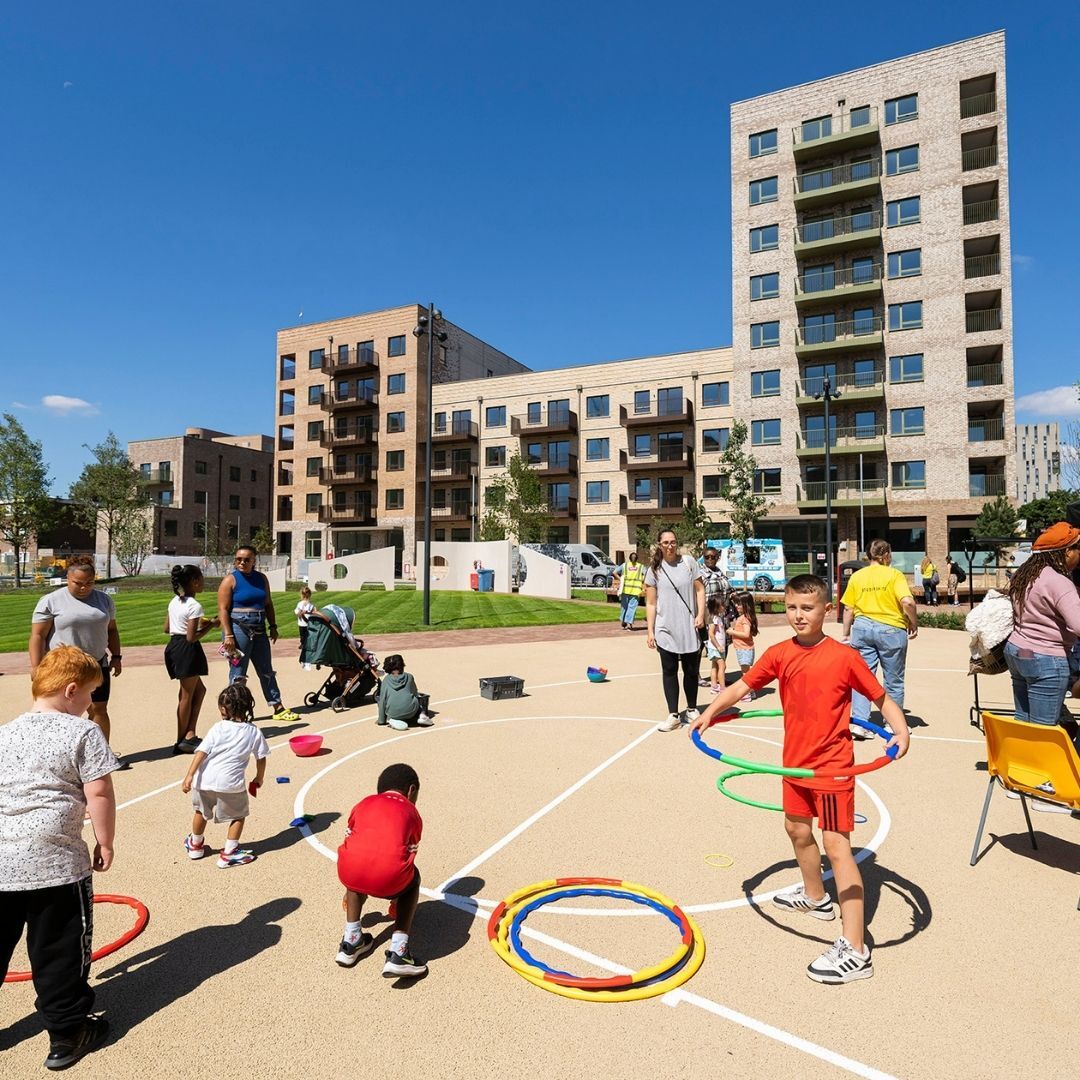Get updates from The Developer straight to your inbox Yes, please!
Gascoigne East Phase 2, London Borough of Barking & Dagenham, for London Borough of Barking & Dagenham and Be First, with White Arkitekter, Civic Engineers, Turkington Martin and Willmott Dixon

Phase II of the redevelopment of the Gascoigne neighbourhood consists of 434 apartments and four townhouses, at a cost of about £135m. With 62% of the housing designated as affordable or shared, the remaining 38% of homes are for private sale. The 46,500sqm project includes a 5,000sqm park co-designed with students from local Greatfields School, which sits in the heart of the neighbourhood.
Who is on the project team? (designer, consultants, etc)
Architect: White Arkitekter, Landscape: White Arkitekter - Concept for Public Realm & Courtyards, Turkington Martin: Gascoigne Square Park and Delivery, Structural & Civil Engineer: Civic Engineers, Fire Engineer: Affinity Fire, Design Manager / Contractor: Willmott Dixon, Planning Consultant: Be First, Community Engagement: Urban Symbiotics & Be First, Acoustics: Mach Acoustics, MEP: THD and Kane
Describe the context of this project, its neighbourhood and people.
The reimagining of the Gascoigne neighbourhood is at the heart of the council’s ambition to regenerate Barking as one of London’s greenest, most affordable, and sustainable neighbourhoods. Built in the 1960s, the existing estate featured deteriorating high-rise towers, low rise blocks, and a lack of useable community space. The project was an opportunity to regenerate the neighbourhood, deliver new apartments, townhouses, community facilities, and a new park in a place where people will want to live. It raises the bar for affordable housing with modern, spacious homes and a rich mix of open spaces and nature. The architectural composition of the new buildings responds to its surroundings; the tall buildings of Barking Town Centre to the north, and the perimeter blocks in the south. New green urban realm links encourage walking and cycling to Barking Town Centre and its bustling high street of independent shops and market. The neighbourhood has embraced high-quality Scandinavian urban design principles that respect the context while adding to London’s rich mix of old and new architecture. Through thoughtful design elements including high-performance building fabrics and dual aspect homes with natural light and both shared and private gardens, the neighbourhood has achieved a balance between preserving its heritage and embracing modern development to fuel social wellbeing and a sense of community. Ground floor shops, homes and a variety of public spaces enliven the public realm, with community activities, like gardening, improving people’s quality of life.
How has this place adapted, and how does it continue to adapt, to changing demographics, behaviors, market context, policy, transport habits and the climate crisis? What makes it resilient?
The area’s problems with crime and youth struggles are well-known. The design of the neighbourhood strives to address these challenges and changing demographics synonymous with regeneration, by providing future-proof, sustainable and community-focussed infrastructure and public realm. Tackling the estate’s previously poor-quality public space and open carparking areas, the placemaking strategy set out the delivery of a car-free, pedestrian and cyclist-friendly solution incorporating underground refuse collection systems. The design of the public realm prioritises safety, with open space, good lighting and sightlines, and ‘eyes on the street’, so people feel at ease walking around the neighbourhood. Gated shared courtyards at the centre of the residential blocks provide a safe outdoor play place and meeting area. The streets, parks and courtyards have been designed to be climate resilient and increase biodiversity. Sustainable Drainage Systems (SuDS) are integrated into the park and landscape using raingardens and permeable paving to reduce the volume of underground attenuating storage tanks. Green urban realm links encourage walking and cycling over car use to promote healthier streets and greater wellbeing. Existing routes are revived with pocket parks, play on the way and lighting to remove barriers and improve safety. There are a wide range of tenure options across Gascoigne East Phase 2 – of the 546 homes being delivered there, 15% are affordable rent, 20% are London affordable rent, 51% market rent, 14% shared ownership. To encourage active, sustainable travel, around 1000 cycle spaces are included in the new development.
Please share any data or evidence about the social, economic and environmental performance of this place, or any relevant figures such as footfall, visitors, engagement metrics, residents, etc
All homes are linked to the district heating system where 69% of the heat is supplied by WSHP from the River Roding. Photovoltaic panels on the roofs and high-performance fabric reducing operational energy demands, lowers residents’ bills - vital amid the cost-of-living crisis and unprecedented energy costs. The block of eight homes has been delivered to Passive House standards. The delivery provided £78.6m SROI in the area. Employment for local people was supported through apprenticeships, work experience and mentoring sessions to help with interviews and CVs. Engagement with local schools was important. White Arkitekter held workshops with girls from Greatfields school for the design of parks and playgrounds, as covered in Evening Standard and EGI. The students also collaborated with a local artist for site hoardings. Links: www.standard.co.uk/homesandproperty/property-news/redesigned-for-girls-white-arkitektur-gascoigne-estate-barking-park-design-b1065428.html www.egi.co.uk/news/places-for-girls-design-that-makes-a-difference/ The neighbourhood’s new 5000 sqm Gascoigne Square Park manages stormwater sustainably with soft landscaping, permeable landscape, and swales. The design targeted a 40% reduction in CO2 emissions from energy produced by the homes compared to building regulations. “The area previously felt very secluded from view of others and there were no streetlights, which added to the sense of danger,” says Kelsey Morey, a year 11 student at Greatfields School. “I feel more confident in my ability to go out alone during the day.” White & Civic investigated retrofit for the final phases of the masterplan as discussed on the developer podcast Link: thedeveloperlive.co.uk/podcasts/podcasts/breaking-the-cycle-of-demolish-rebuild The Developer podcast on Gascoigne designing for community and co-design Places for Girls.
Sign up to our newsletter
Get updates from The Developer straight to your inbox
Thanks to our organisation members
© Festival of Place - Tweak Ltd., 124 City Road, London, EC1V 2NX. Tel: 020 3326 7238